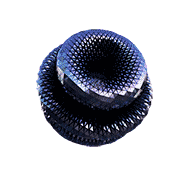|
Apache posted:I brewed my first Grainfather(US model) batch yesterday and here are my first impressions. Did my second yesterday. As for the speed to ramp up, definitely flipping to 'normal' will help. Even with that, I started with the tap water at its hottest (which yesterday was 133°) and ramp up from there. I also bought a heat stick for prepping the sparge water and speeding up the ramp-up to boil, but for whatever reason the fucker couldn't get the sparge water over 155° despite it having no issues getting to 169° on my first batch. If it's already failing to work at full bore it's going back and I'll just learn how to DIY a brewing-purposed heat stick for the same application. Ran into a trio of issues I'll need to solve for...I had an incredibly slow sparge; used almost a pound of flaked oats in the recipe and thought adding about 8oz rice hulls would help things along, but that didn't seem to matter. My volumes pre-sparge and post-boil were what I wanted, but that also included me getting out the heavy gloves and doing some manual compression of the grain bed after a while to pull out what I was hoping to get from the mash. More manual work than I'd prefer to do. I'm not sure if I needed more rice hulls, more mash water, or what. Second issue came from adding 16oz of candi sugar during the boil. I kind of forgot about needing to keep the boil moving around the element, and (from what I can surmise after draining the GF) a bit too much sugar ended up cooked onto the bottom of the pot by the heating element. I started the boil and ran around the house doing errands, then came back an hour later to the temp showing 207° and the liquid clearly having been sitting still for a few minutes. A slight tilt, reset of the switch on the underside, unplug/replug, and we were back in business for the last 15-20 minutes of the boil. Knowing that's likely what happened at the time, I wanted to scrape the heating element with my paddle, and I'm pretty sure around this time I knocked off the black rubber end cap of the filter. The transfer into the fermenter was actually pretty clear (somehow?) so maybe I knocked it off later than I thought? I've always used tap water to start with my CFCs, then switch to an ice bath as the source. Yesterday I ran it straight from the GF to the fermenter, one shot, with ice water, and was fully transferred in 20 minutes at 68°. This, in a house that was about 84° yesterday. Unbelievably pleased with that. I realize that's largely just due to a change in how I try to chill the wort, but drat it if I wasn't happy seeing that. Yesterday's brew seemed to go rockier than my first (the lovely heat stick played a big role in that I guess) but my volumes were nailed and the whole process would have needed to have a lot more problems along the way to cancel out the ease of cleaning everything when all was said and done. I'd welcome some sort of all-metal filter mod for that thing, though, which I could feel confident in knocking around with the paddle to no ill effect.
|
|
|
|

|
| # ? May 30, 2024 20:23 |
|
Busy beer day for me yesterday. Brewed up the imperial stout that I bought the ingredients for last week. Ended up missing my OG by a few points because my efficiency took a bigger hit than I thought, but it was close enough to not care. Should still finish about 11.5%. I plan to toss in some oak cubes that I steam sanitized and tossed into a mason jar of bourbon and I may toss the bourbon in too, so it'll probably end up about where I'd originally planned to end up anyway. Also, fermcap is a godsend for big boils. I bought some yesterday to actually use when I'm stepping up yeast starters, but I realized just how close to the top of my 10 gallon kettle my boil was and decided to throw some in. Zero problems with boil over because of it. I pitched a stepped up WLP001 starter last night around 9PM and checked it at 5PM today and it was ripping. drat near singed my nose hairs off looking into the chamber to make sure nothing was leaking out of the valve on my SS brew bucket. During that brew time, I also cleaned out the saison keg that kicked and flushed and sanitized the lines to get it ready for the meyer lemon Kolsch that I had waiting. I also kegged the Oktoberfest that I cold crashed a few days prior and tossed that in the kegerator for lagering. Side note, does anyone have any experience with the faucets that are built right onto a ball lock post? My college alumni club is going to a big event college tailgate type of event next month and I offered to bring a keg to share with people who stopped by our tent. Right now I have no way to dispense beer not from my kegerator so I was looking into one of those post faucets and a co2 cartridge type of thing for dispensing gas. Looks like I can get both for about $50 or so combined. I don't expect to do this kind of stuff often so I'm not looking to get another actual co2 tank and regulator.
|
|
|
|
It's happening! Just a mockup of the collar on top of my cooler. Still need to clean up some edges and paint it, then attach the hinges and that part is done. The end is nigh.
|
|
|
|
rockcity posted:Busy beer day for me yesterday. The little ~16g chargers? They're sometimes a little crappy but they'll work. Make sure you're properly carbed first though.
|
|
|
|
Nanpa posted:The little ~16g chargers? They're sometimes a little crappy but they'll work. Make sure you're properly carbed first though. Yeah, I'm not looking for perfect. A friend of mine used one to dispense a keg once and it seemed to work fine. The faucet on the post was more of what I was curious about. I hadn't even seen one until I was looking online for a picnic tap and found that. I wasn't sure if having the picnic tap on a line would be better than an actual faucet with no line. I'm guessing you just need to minimize the serving pressure with the chargers.
|
|
|
|
This is the part that adapts the flare fitting on the QD to the back of the beer faucet: http://www.morebeer.com/products/qd-faucet-adapter-adaptor.html With that, use whatever kind of faucet you like (except the description there says it doesn't work with Perlicks, Ventmatics or flow control faucets. So probably just the regular chromed kind). But yeah, you're going to have issues getting a decent pour. I'd get the keg as cold as you can, agitate it as little as possible, keep it ice cold at the remote site, and keep just enough pressure on it to make the beer flow. This will probably be less than equilibrium pressure, so the beer will tend to outgas over time. You might actually end up having to bleed gas off if you're only drawing a couple of beers every now and then. Jo3sh fucked around with this message at 06:08 on Sep 10, 2015 |
|
|
|
Jo3sh posted:This is the part that adapts the flare fitting on the QD to the back of the beer faucet: Thanks for the tips. This is actually what I was looking at, mostly since the only faucets I have are Perlick's and pretty much none of these post adapters work with them. http://www.amazon.com/Faucet-Chrome...all+lock+faucet I'd only be dispensing beer for maybe 2 hours so I'm not to worried about the outgassing. My plan would be to move the keg a couple hours before the event, keeping it pinned vertically between my front and rear seats. Then put it into an ice bucket on site and let it rest until the event for everything to settle back down before serving.
|
|
|
|
ChiTownEddie posted:If I remember correctly it was something like: Its so freaking good. Bready, light, hint of malty caramel-y-ness...I already think that since I'm brewing this for a family homebrew competition I need less MO and more wheat, but still for my first attempt...holy crap do I love it. The gravity is still higher than I expected so I raised the fermenter to 67 or so to see if it drops some more.
|
|
|
|
Tell me about fruiting my lambic. I've added fruit to beer before but it usually only sits for 2 months. I just brewed up 5 gallons of lambic and I've got 15 lbs of fresh local NJ peaches and nectarines that I want to add to it. My issue is that there's so much conflicting info out there. Cantillon puts their lambic on fruit for 8 weeks or so but Allagash lets Farm to Face sit on peaches for 10 months. It seems like everyone does it differently. What would you do? Long primary with fruit at the end or short primary and let the fruity goodness mature for a long time?
|
|
|
|
I aim for 2-3 months on fruit but almost always go longer. I think that too many factors go into it to have a good 'this is better' rule.
|
|
|
|
HatfulOfHollow posted:Tell me about fruiting my lambic. Long primary with fruit at the end. I'd rather taste the results of fruit aging in the bottle than in the carboy. EDIT: Either way, the beer tells you when it's ready.
|
|
|
|
more falafel please posted:I wouldn't be worried about scratches in a mash tun. You're boiling anything that comes out of it for an hour+ within minutes of it coming out. The grain going into the mash tun is also full of bugs. Yeah. You can also full it with near boiling water to sterilize it. This also works for buckets, even contaminated ones.
|
|
|
|
I got the Short Pour newsletter from Northern Brewer yesterday, and now I'm all hot-to-trot to make some hard ciders this fall. Is there anything really oddball in cider making that would trip up someone who has spent a year doing all-grain tier beer brewing?
|
|
|
|
Nth Doctor posted:I got the Short Pour newsletter from Northern Brewer yesterday, and now I'm all hot-to-trot to make some hard ciders this fall. Not really. It is considerably easier process wise, but probably more dependant on the quality of your raw materials. A few pointers: Yeast nutrient is really helpful, juice often lacks nutrients. Juice/cider made for drinking is not ideal for fermenting, but it is very hard to obtain good hard cider suitable juice. That said, you can make perfectly acceptable cider with motts apple juice and some added sugar. Edwort's apfelwine is the most popular recipe around. Cider made from drinking juice tends to be a little too fermentable and lack flavor/tannins after the yeast is done. A cup of strong black tea can help with this. Unless you kill the yeast and keg carbonate you have to choose between sweet cider and sparkling cider. Unless you use super low attenuation yeast, it will finish quite dry. Don't use ec-1118 (or really any champage/wine yeast) unless you like waiting a long time and like super dry cider (and quite possibly flavorless). I'd strongly recommend a moderately attenuating English ale yeast to start with.
|
|
|
|
Cider you say????RagingBoner posted:Just made an AMAZING cider. I've tried all sorts of methods, but this has the best results with the quickest turnaround.
|
|
|
|
This is the recipe by edwort off homebrewtalk. Apfelwein (German Hard Cider) This took 1st Place at the 2007 Alamo City Cerveza Fest BJCP sanctioned competition for the Cider and Apple Wine Category and 2nd Place for Best of Show for Meads & Ciders! Ingredients 5 Gallons 100% Apple Juice (No preservatives or additives) I use Tree Top Apple Juice 2 pounds of dextrose (corn sugar) in one pound bags 1 five gram packet of Montrachet Wine Yeast Equipment 5 Gallon Carboy (I use a Better Bottle) Carboy Cap or Stopper with Airlock Funnel First sanitize the carboy, airlock, funnel, stopper or carboy cap. Open one gallon bottle of apple juice and pour half of it into the carboy using the funnel. Open one bag of Dextrose and carefully add it to the now half full bottle of apple juice. Shake well. Repeat Steps 2 and 3, then go to step 5. Pour in the mixture of Apple Juice and Dextrose from both bottles into the carboy. Add all but 1 quart of remaining 3 gallons of apple juice to the carboy. Open the packet of Montrachet Yeast and pour it into the neck of the funnel. Use the remaining quart of juice to wash down any yeast that sticks. I am able to fit all but 3 ounces of apple juice into a 5 gallon Better Bottle. You may need to be patient to let the foam die down from all shaking and pouring. Put your stopper or carboy cap on with an airlock and fill the airlock with cheap vodka. No bacteria will live in vodka and if you get suckback, you just boosted the abv. There’s no need to worry about filling up a carboy so full when you use Montrachet wine yeast. There is no Kreuzen, just a thin layer of bubbles. I'm able to fit all but 4 oz. of my five gallons in the bottle. Ferment at room temperature. It will become cloudy in a couple of days and remain so for a few weeks. In the 4th week, the yeast will begin to drop out and it will become clear. After at least 4 weeks, you can keg or bottle, but it is ok to leave it in the carboy for another month or so. Racking to a secondary is not necessary. It ferments out very dry (less than 0.999, see here) If you want to bottle and carbonate, ¾ cup of corn sugar will work fine. Use as you would carbonate a batch of beer. Remember to reserve judgment till after 3 glasses. It grows on you.
|
|
|
|
I had a batch of cider last year that I hit with campden/sorbate and sweetened with apple juice concentrate in the keg. It's very, very sulfury, to the point where I'll choke it down but I don't even label the tap on the keezer because I wouldn't want anyone else to drink it. Unfortunately, I didn't taste it before stabilizing/sweetening, so I don't know if it happened during fermentation or because of stabilizing. I know cider can throw off sulfur, but it's never happened like this before for me.
|
|
|
|
Put a small piece of copper in the keg like an old penny, it will magically make the sulfur go away.
|
|
|
|
The Kolsch I made took gold in a local(-ish) competition in the Pale Bitter European Beer category on Sunday! My Rye-PA won a competition earlier this year, but this is my first BJCP-sanctioned event and am really happy with how it turned out, so I thought I'd share the recipe: This was for an 11 gallon batch, and I assumed 72% total efficiency. I modified 15 gallons of RO water to match the Cologne water profile in Beersmith2 to use on this brew. 1.047 OG 1.009 FG 26.7 IBU 16 lbs Pilsner Malt 2 lbs Vienna Malt 1 lbs White Wheat Malt 8 oz Carapils 3 oz German Tradition (4.5% AA) @ 60 minutes 1 oz German Tradition (4.5% AA) @ 15 minutes Strike with 7 gallons of water to achieve 149F mash for 60 minutes. Batch sparge at 168 F to make pre-boil volume (my pre-boil was 13.5 gal). A 3L starter of WLP029 on a stirplate should yield plenty of yeast left over to capture for the next brew. Fermented 10 days at 60F, crashed to 34F for 13 days. Added gelatin, left it at crash temperatures for another week, then transferred and carbed to 2.6 volumes, and was left with something that you could see right through:  Why yes, that is the neighbor's driveway across the street! 
|
|
|
|
more falafel please posted:I had a batch of cider last year that I hit with campden/sorbate and sweetened with apple juice concentrate in the keg. It's very, very sulfury, to the point where I'll choke it down but I don't even label the tap on the keezer because I wouldn't want anyone else to drink it. Unfortunately, I didn't taste it before stabilizing/sweetening, so I don't know if it happened during fermentation or because of stabilizing. I know cider can throw off sulfur, but it's never happened like this before for me. Did you let it off-gas after your Campden tablets? Because that's a likely suspect. I just put 10 gallons into two carboys much like that Apfelwine recipe. Granted, I used much less additional sugar so it won't be quite that strong. I'm going to play around with the flavors once it's done fermenting, and back sweeten some of it to see how it all turns out. The good news is that I can much more easily break it up into multiple tests as I go because of how you can mess with flavors of cider once it's done fermenting. I expect to get about 4-5 different experiments done just from 10 gallons. That copper penny thing though, that's quite an interesting idea. I'll have to figure out why that works.
|
|
|
|
Der Penguingott posted:
I don't see this said often, but you don't really even have to add sugar. The apple juice I've gotten from Costco comes in at around 1.05 to start and ferments all the way out, which is plenty strong for me, and isn't quite so painfully bone dry and boozy when it's done.
|
|
|
|
Glottis posted:I don't see this said often, but you don't really even have to add sugar. The apple juice I've gotten from Costco comes in at around 1.05 to start and ferments all the way out, which is plenty strong for me, and isn't quite so painfully bone dry and boozy when it's done. This is exactly what I do, usually with S-05 or S-04 (or even with any old ale cake I have after a transfer, currently making some with a yeast I used for a saison) finishes dry every time, but as you said, not painfully so
|
|
|
|
http://i.imgur.com/ELq3CCF.jpg Sup goons, I got these hops in a big buy of used stuff on craigslist, the guy I bought it from said they were homegrown cascade hops that have been sitting in a closed box for the last 2 years plus they're vacuum sealed. Do you think they're still good? It also came with like 15 pounds of Maris Otter thats not milled, I assume that thats still good right?
|
|
|
|
Please brew something using those hops and post the results here.
|
|
|
|
HatfulOfHollow posted:Please brew something using those hops and post the results here. But there's no way they can still be good right?
|
|
|
|
Thanks! I just threw a bunch of that info into my brewing evernote notebook.
|
|
|
|
Nerd Grenade posted:But there's no way they can still be good right? There's only one way to find out. e: Open them and smell them. If they smell OK, brew with them.
|
|
|
|
Glottis posted:I don't see this said often, but you don't really even have to add sugar. The apple juice I've gotten from Costco comes in at around 1.05 to start and ferments all the way out, which is plenty strong for me, and isn't quite so painfully bone dry and boozy when it's done. I added all of 5oz to boost it slightly. I am using Montrachet for my yeast, and if I'd planned better I would have used wyeast 3711 for half of it too. I got a few bottles of cider from someone who boosts to 9%, and it's indeed too dry and strong for my wife. I'm okay with it, but it tastes a little more like wine than it does apple. I guess I'll find out how about 1.06 will turn out.
|
|
|
|
Nerd Grenade posted:But there's no way they can still be good right? Probably not, but hey, you could always let them oxidize for a bit and brew sour beer with them.
|
|
|
|
Going back to the discussion on house beers - I'm currently sans keezer but I like to have 1. Something session able that varies with the season. Mild or English bitter when it's cooler weather, kolsch or pale lager in warmer months 2. Something hoppy because anyone will drink either the session beer or the hoppy beer 3. Something heavier, saison, porter, lighter stout, red ale etc. depends on season 4. Cider or perry, session able. Usually prefer tatt over sweet 5\6 are whatever the gently caress I want taps. And I would like to have something on the hand pump/s (I have two, thanks to Jo3sh for the UK eBay suggestion!!) at all times depending on what time of year. Sours and British really only will go in these. Speaking of, I've been loving about in Solidworks in my down time at work and at home and rendering my bar and will eventually take plans to my fabricator for work who will do it in 304 stainless which I plan on polishing up. The weird bits on top of the caps are vintage style bulbs which I plan to fit up, in a similar finish with a stainless cage. Big plans and eventually will happen! Just need to start sourcing the flanges. It has a door on the back for quick access to tap lines etc. 
|
|
|
|
Jhet posted:Did you let it off-gas after your Campden tablets? Because that's a likely suspect. I'm guessing it's the campden. I forget now if I left it with the airlock on for a while or just threw the campden/sorbate/concentrate in the keg. If I just left it with the airlock on it should offgas, right?
|
|
|
|
more falafel please posted:I'm guessing it's the campden. I forget now if I left it with the airlock on for a while or just threw the campden/sorbate/concentrate in the keg. If I just left it with the airlock on it should offgas, right? I've gotten sulfur on several ciders that didn't get any sulfites. It usually ages out after 6-9 months.
|
|
|
|
more falafel please posted:I'm guessing it's the campden. I forget now if I left it with the airlock on for a while or just threw the campden/sorbate/concentrate in the keg. If I just left it with the airlock on it should offgas, right? I really don't know. I added the campden before fermentation and let it off gas for 24 hours. I don't plan on adding any after fermentation. I imagine if you let it off-gas after fermentation and before carbing you could probably accomplish the same thing, but I haven't tried it, because I don't keg and just started doing ciders. Strangely, I've found that good cider information is hard to find on the internet. At least with beer there's plenty of easy places to sift through all the information you could ever need and a lot you won't ever need.
|
|
|
|
IMO the issue with cider is that it's very fermentable, tastes better with some sweetness, and preferred with carbonation vs still. It's a bad combo because you either have to get tricky with yeast/gravity, use unfermentable sweeteners, pasteurize, or keg.
|
|
|
|
Nerd Grenade posted:But there's no way they can still be good right? I have several pounds of hops I bought during the simcoe and Amarillo shortage a couple years ago in vacuum sealed bags in my freezer. They are still great.
|
|
|
|
Aren't aged hops kind of great for lambics? I don't remember the specifics, something about them losing their innate antimicrobial/preservative properties (so you don't burn out your wild yeasts)
|
|
|
|
robotsinmyhead posted:Aren't aged hops kind of great for lambics? I don't remember the specifics, something about them losing their innate antimicrobial/preservative properties (so you don't burn out your wild yeasts) Yeah lower alpha aged hops though, cantillon uses something like 3 year old aged hops just to add maybe 1-2 ibu of bitterness. Primarily it's because lacto and pedio struggle with even more than 8-9 IBU in a beer, and because they're bringing so much character to the beer as it stands you want them to do their work. Also if you're brewing a lambic don't gently caress about and just mash high, go the proper turbid mash. Sure it's a big brew day, but you can tell the hard work at the end of the day. I follow this as my guide Mash in at 45, thick mash. Hold for 10. Water to grain around 0.7L/kg or 0.3qt/lb of water Add boiling water to 58C After 5 minutes pull off 1-2 litres of liquid only, heat it as quickly as possible to above 82C and maintain Once it has all finished heating, add boiling water up to 66C. Let it rest for 30 mins, pull off about 4 litres and add to the decoction, reheat. Add more boiling to 72C. 20 min rest Drop out about the same volume of liquid into your boil kettle as what's in your other vessel, warm it to about 80 as well. Add the turbid section you pulled off (the decoction) to get the mash to 75, hold for 20, vorlauf, sparge with 88 degree water. Boil for approximately 4-6 hours in order to get those complex chains broken down a bit by the process. I did this process for a Flanders red ale recently and I think it tasted incredible. I could actually smell all those individual malt characters throughout the boil, so some Pilsner character, the special B made a big presence with massive fruity flavours, and the other specialties were there too. It's a big day, but something I recommend trying for sours. Also that's based on a 19 litre 3V method. BIAB would double all the volumes of decocted wort and the boiling water additions would all increase a bit.
|
|
|
|
Bacteria don't exactly struggle at higher IBUs. Vinnie at Russian River hops all of his sours to like 20 IBUs. I do at least 15 in mine. And I have a sour IPA right now that's like 70. deedee megadoodoo fucked around with this message at 01:58 on Sep 12, 2015 |
|
|
|
HatfulOfHollow posted:Bacteria don't exactly struggle at higher IBUs. Vinnie at Russian River hops all of his sours to like 20 IBUs. I think there are a few strains that do not struggle. Check out Milk The Funk for strains that are not IBU tolerant.
|
|
|
|

|
| # ? May 30, 2024 20:23 |
|
Speaking of ancient Craigslist ingredients, I decided I'd use that 4 year out-of-date Coopers kit (and accompanying sealed bag of malt of similar vintage) for a practice run today, of what I call Ironic Stout. I'll drink it if it's passable, but I'm fully expecting to pour it down the drain, just figured I might as well try a wet run with free, dodgy ingredients before my first real brew. Filched a sachet of yeast from one of my new kits* and pitched that, otherwise just followed the instructions on the tin. Forgot about the house's old finnicky plumbing, and a bit late felt some of the splash of the water as it was going in go from cool to pretty warm, wort got up to like 38C according to stick-on thermometer, ugh. I dumped some ice in and filled the remaining 3L with cold water and got it down to 26, then added yeast. If I had another FV I'd be tempted to fill it with water at just the right temp and empty that into my primary fermentor, but it's not rocket science with the tap, just need to be a bit more careful. Will be sure I've got ice on hand next time just in case. Made what Google tells me is a common rookie mistake and pushed the O-ring into the brew when I was fitting the airlock, just wrapped a bunch of saran wrap around the base of the airlock, wedged it firmly in the hole, and used a bit of tape to hold it there more firmly. Fermentor is now sitting on top of the washing machine, with some old shirts on the bottom for insulation, also wrapped in a thick blanket with the sterilised aquarium heater inside set for 21C. *Going to try and reconstitute some yeast from a six-pack of Coopers Pale Ale for that Dark Ale kit, which a post on another forum suggests will take about a week and a half; waiting a week for the sediment to settle before emptying out the beer, then another ~3 days with the yeast munching on the added sugar solution. Should be timed pretty well with when I'm ready to bottle the crap stout, fortunately I have just enough bottles for two batches. Think I will bulk carb the stout with some caster sugar and give it 4 weeks or so to come around right, if it's undrinkable I'll dump it and brew something with fresh ingredients so its ready by early December, when I've got some mates coming. Pompous Rhombus fucked around with this message at 04:28 on Sep 12, 2015 |
|
|































